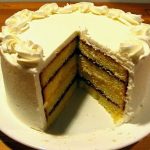 A baked mixture of flour, milk, egg, sugar, flavoring and leavening agent.
A baked mixture of flour, milk, egg, sugar, flavoring and leavening agent.
From a linguistic point of view, the defining feature of cake is not its taste or its ingredients, but its shape: cakes are round but flat on top, whether they are made from bread dough (as they originally were back in the thirteenth century) or from flour and sugar (as they have been since the fifteenth century) or from ammonia (as they have been since the invention of the modern urinal). The word cake derives from the Old Norse kaka, and is therefore related to the Dutch word that gave English cookie, but is not related to the Latin source that gave English cook. The expression That takes the cake, meaning that something is outlandish or fantastic, and the word cakewalk, meaning that someone found something easy to do, developed when American slaves established the tradition of giving cakes to the best dancers at social gatherings.
In the United States, cakes can be categorized based on the method used to mix the batter: creaming, one-step, or sponge/foam method. Regardless of the method used, it is crucial to measure ingredients accurately, as cakemaking is a precise science. The two primary leavening agents used in the United States are baking powder and air. Recipes for cakes made using all three mixing methods can be found in this collection. By following the proper techniques and using quality ingredients, anyone can create a delicious cake that is sure to impress.
